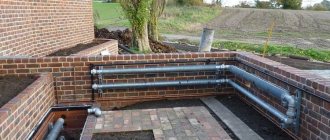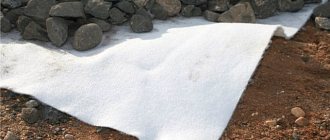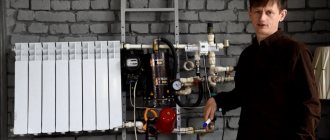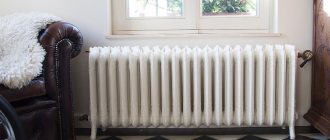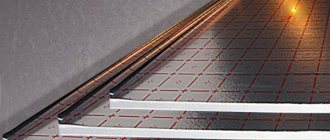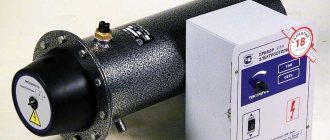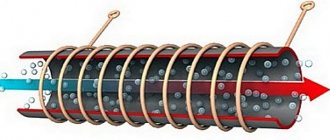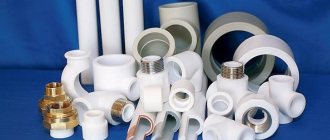A heating register is an integral part of the heating system, a device consisting of several parallel horizontal smooth pipes. This type of heating device has not gained much popularity among private homeowners, and there are objective reasons for this. A register-based heating system has a large volume of coolant, which requires much more energy to heat than with conventional radiators.
A mobile heating register with a built-in heating element allows you to move the device to another location in a short time in case of an emergency.
Application area
Currently, water heating registers are mostly used in industries (workshops, workshops, warehouses, hangars and other buildings with large areas). The large volume of coolant and large dimensions allow the registers to efficiently heat such rooms.
The use of heating registers in industrial buildings ensures the most optimal efficiency of the heating system. Compared to cast iron or steel batteries, registers are characterized by better hydraulics and heat dissipation. The relatively low cost of their manufacture reduces the cost of installing the entire factory heating system. In addition, they are not expensive to operate.
Registers are also recommended for use in premises with high sanitary safety requirements (medical institutions, kindergartens, etc.). The devices are easily washed from dirt and dust.
Despite this, the concept of efficiency does not apply to this type of heating device. As noted above, heating a large volume of coolant requires a lot of energy.
Heating registers at one of the food industry production facilities in the Moscow region.
Heating registers made of steel electric-welded pipes can be used in both single-pipe and two-pipe heating systems with forced or gravity circulation of the coolant (based on water or steam).
Note! Due to the large volume of coolant, which requires a lot of fuel to heat, only enterprises can afford to use heating registers, but not the owners of private houses, for whom the efficiency of the heating system is important.
Filters
Mud filters are essential elements of modern heating systems. When installing mud filters, it is important to take into account the rules for their installation, since it is during installation that mistakes are often made. It is also important to remember to clean them from time to time. Sometimes it is enough to install one dirt filter into a closed heating system. It is installed on the section of the main line through which all the coolant passes. Such a place could be, for example, the area in front of the main circulation pump.
Basic rules for installing mud filters:
- It is preferable to install the filter on horizontal sections of the pipeline.
- When installing the filter, it is important to ensure that the direction of movement of the coolant coincides with the marks marked on the body of the device.
- The tap branch, equipped with a screen, nut (or drain cock), should be located at the bottom.
- The dirt filter must be installed in a place that is easily accessible for maintenance.
- Shut-off valves (half-turn valves) should be installed at the inlet to the filter, as well as at the outlet.
Advantages
- The large length of the devices (up to 6 m) allows you to heat the entire area of the room evenly and in the shortest possible time.
- High hydraulic characteristics.
- Relatively low price. The cost of a mobile 3-pipe device (designed for heating a room with an area of up to 200 m²) with steel pipes with a diameter of 108 mm, a wall thickness of 3.8 mm and a length of 3 m, with a built-in heating element with a power of 2.5 kW is about 13,000 rubles.
- Easy to use. The devices can be easily and quickly cleaned from accumulated dust and other contaminants.
Mayevsky tap at the top of the register.
Let's start installation
The sequence of work depends on the design features of the heat exchanger.
Installation of a device with a register
When installing in an old furnace, you will have to dismantle part of the masonry. The sequence of work is as follows:
- We prepare the foundation for the coil right in the firebox cavity.
- We install the coil.
- We lay the disassembled row of bricks, leaving space for the inlet and outlet parts of the pipes.
- We connect the heat exchanger to the heating system.
Before use, the tank must be checked for leaks. You can make sure there are no leaks by filling it with water, preferably under pressure.
Installation of a device with a container
The best option for a stove or fireplace. Made from a metal tank and two copper tubes. The tank volume is usually about 20 liters. In the absence of a finished product, a tank of sufficient volume is made by hand by welding sheet steel.
For the manufacture of the heat exchanger, a material thicker than 2.5 mm should be used. Welding should be done in such a way that the thickness of the formed seam is minimal.
The tank must be installed 1 meter above the floor level, but no further than 3 meters from the stove. Two holes are made in the tank: one near the bottom, the second at the highest point on the opposite side. The efficiency of heat transfer depends on the location of the lines.
It is necessary to strive to ensure that the minimum deviation of the lower outlet in the direction of the floor is 2 degrees. The top one should be connected at a 20 degree angle in the opposite direction.
The drain valve is being installed in the storage tank. There is another tap designed to drain the entire system, which is installed at the lowest point. After checking the tightness, the system is ready for operation. The efficiency of such a stove with a heat exchanger can be appreciated in the cold season.
Flaws
- The large volume of coolant does not allow efficient use of registers in private homes. Home boilers simply will not be able to heat such an amount of water, or the heating will be insufficient.
Advice! To increase the power of the entire heating system of a private house, in addition to the boiler, a tubular electric heater can be installed. The heating element is mounted in the lower pipe of the register and is an additional source of heat. In the coldest weather, when the boiler cannot cope with heating the house, you can turn on the heating element.
System recharge
Closed-type heating systems are equipped with outlets for recharging the circuit with coolant. If water is used as the coolant, the return heating circuit can be connected directly to the water supply. The replenishment will be done through shut-off valves and a mud filter (a softener filter will also be useful here).
A pressure gauge will help track the pressure difference in the forward and return lines.
If antifreeze is used as a coolant, then a special branch is made in the circuit for pumping antifreeze. Also, do not forget about the coolant drain taps, which cut into the lowest point of the system.
Technical characteristics of heating registers
- Working pressure: 10 atmospheres
- Working medium (coolant): water, steam.
- Connection type: threaded or welded.
- Heat dissipation: 500-600 W/meter
Types of registers.
There are 3 main types of registers:
- sectional U-shaped;
- S-shaped coils;
- “mixed” (U-shaped coil).
The main elements of heating registers are steel pipes (or pipes made of stainless steel grade 304) with a diameter of 25 to 200 mm. Registers with a diameter of 25 to 100 mm are used for heating factory premises for administrative or utility purposes, devices with a diameter of 100 to 200 mm are used in production shops or large sports complexes (swimming pools, volleyball, basketball halls).
As for private households, the use of registers is one of the most ineffective ways to heat a private home.
2-pipe register.
The number of sections of the device can be unlimited and depends only on the area of the room and the required heat transfer.
Advice! If you use too many pipes (more than 4), it will still not be possible to significantly increase the power of the entire device, because The rising warm air heated by the lower pipes will be less able to accept thermal energy from the upper pipes.
Component life and manufacturer's warranty
| Parameter | Radiator Rifar Monolit | Convector TS CARNOT |
| Life time | 25 years | 50 years |
| Manufacturer's Warranty | 25 years | 10 years |
The service life of convectors is 2 times longer. This is achieved due to the almost eternal materials from which the heat exchanger is made: copper tube and aluminum fins. However, the warranty obligations stated in the passport of convectors are lower.
Radiators use less durable steel tubes. It should also be remembered that the warranty is valid only if all installation and operating conditions are fully observed.
Rifar radiator internals
Let's turn to the Rifar Monolit passport.
The very first points of the guarantee in practice turn out to be impossible for a simple buyer who bought a radiator in the nearest market and used the services of a private plumber. In this case, there is neither a project nor licenses, and besides, design costs serious money. After 15 years, in the event of a breakdown, it will be impossible to prove that this breakdown is a warranty case, so it turns out to be easier to buy a new radiator.
To obtain a warranty for a convector, no special conditions are required. If any of its parts fail, an engineer will come and replace them on site.
From practice: in 3 years of working with convectors there were no warranty claims. The specialist was called several times, allegedly with warranty cases, but right at the site it became clear that the damage to the tube was mechanical in nature due to negligence during the repair process. Engineers on site corrected the problem by replacing the heat exchangers.
Manufacturing of heating registers
For the production of heating registers, steel pipes of various diameters (25-200 mm) are used, which are welded together at a distance of 50 mm from each other (reducing the distance between the pipes can lead to a decrease in heat transfer). This distance allows you to achieve maximum heat transfer and minimize mutual radiation.
The register includes supply and return, as well as an air vent with a ball valve installed in the upper part of the device. The supply and return pipes can be made in two versions:
- Threaded connection;
- Welded connection.
When ordering registers individually at the manufacturer, registers can be supplied either ready-made, assembled, or disassembled, which allows you to save money on logistics.
Radiator control and shut-off valves
Heating radiators are equipped with half-turn ball valves, which allow you to completely shut off or, conversely, open the coolant supply to the radiator. Taps are placed at the entrance to the device. Sometimes thermostatic radiator valves (without presetting) are used instead, which automatically shut off the coolant supply when the room temperature exceeds the set values.
The listed devices cannot be used to balance the system. Balancing valves (valves) and thermostatic valves with presetting serve these purposes.
How to make a heating register with your own hands?
Unlike other heating devices, the production of which requires complex, expensive equipment, water heating registers can be made with your own hands. The main thing you will need for manufacturing is smooth steel pipes and the ability to use a welding machine. If you weld it yourself, you will get the cheapest option, but if you have to invite a third-party welder to carry out welding work, such a register may be more expensive than the factory one. In this case, you should think about whether it’s worth doing this yourself or whether it’s easier to buy a factory device.
Connection diagram for heating registers.
So, if registers are made for use in a private home, you will need the following tools and materials:
- Steel pipes with a diameter of 25 to 100 mm, or profile pipes of a similar size;
- Jumpers made of steel pipe with a diameter of 25-32 mm;
- Pipe plugs;
- Inlet and outlet pipes for welding or threaded connection;
- Branch pipe for air vent with ball valve;
- Fastening elements (brackets for fastening to the wall, or floor stands);
- Welding machine;
- Electrodes;
- Welder personal protective equipment (mask, gloves).
- Gas key;
- Angle grinder;
- Centimeter;
- Building level;
Important! If a heating register made of steel pipes acts as an autonomous heating system for a separate room, when the heat source is a heating element built into the device, then in this case it is necessary to install an expansion tank.
Portable heating register with expansion tank and heating element.
After completing the welding work and connecting the components (air vent valve Mayevsky, etc.), the register is pressurized under pressure. If no leak is detected, the device is painted. If a leak is detected, the coolant is drained and the problem area is welded again.
Selecting a heating device configuration
Homemade radiator designs are mainly made on the basis of metal pipes with a diameter of 80 - 150 mm.
Design features are limited to two versions:
- Lattice.
- Snake.
The lattice design of the heating battery differs from the “snake” in a slightly different circuit design, and, depending on the variations in such batteries, the distribution of the coolant may be different.
Options for circuit design of heating registers for their own production: 1 – one jumper and one-sided power supply; 2 – two jumpers and one-sided power supply; 3 – two-way power supply and 2 jumpers; 4 – two-way power supply and 4 jumpers; 5, 6 – multi-pipe
Coil structures actually have a monotonous design, implying strictly sequential movement of the coolant.
Lattice registers are constructed according to different schematics:
- with one or two jumpers and one-way power supply;
- with one or two jumpers and versatile power supply;
- parallel connection of pipes;
- sequential connection of pipes.
The number of pipes in one assembly can range from two to four or more. Rarely, there is also the practice of making single-pipe registers.
A coil assembly usually contains at least two pipes connected on one side by a blind jumper and on the other by a through jumper, which are made from two pipe bends (2x45º). It should be noted that the design of heating registers in the form of a coil is used much less frequently than “grid” designs.
Options for the possible manufacture of “snake” type registers. For coil-type register battery designs, the choice of manufacturing options is limited compared to lattice-type designs.
Both manufacturing options - lattice and coil - can be made not only on the basis of classic round pipes, but also on the basis of profile pipes.
Profile pipes seem to be a somewhat specific material, since they require a slightly different approach when assembling heating radiators. However, registers made from a profile pipe are more compact and take up less usable space, and this factor is also important.
How to improve register efficiency?
Registers have a relatively small heat-transfer surface and to increase it, metal plates can be used, which are welded vertically to the pipes. The result is a kind of finned tube.
4-pipe register with profile convector pipes.
In addition, the registers can be improved in such a way that they will “produce” convector heating. To do this, instead of metal plates, round or profile pipes are welded vertically onto the front of the device, which will create a convection effect. Convection is based on the fact that hot air always rises. Cool air located in the floor area is drawn in through the bottom of the pipe and, when heated, rises. As the air passes through the pipe, it heats up and exits, already heated, through the top of the pipe.
Automatic faucets
Three-way mixing valves are devices that allow you to automatically reduce/regulate the temperature in the supply line by mixing cooled coolant from the return line into it. The fact is that the boiler sends coolant with the same temperature to all heating circuits. At the same time, heated floors have strict requirements for maintaining temperature conditions, and the temperature in the heating radiator circuit is usually higher than in the heated floor circuit. Mixing valves allow all circuits of the system to reach the desired temperature.
Calculation of heating registers made of smooth pipes
The calculation is made using the following formula:
Q = 3.14*D*L*K* (Tr – To), where
- Q – pipe heat transfer
- D – pipe diameter (measured in meters)
- L – pipe length (m)
- K – heat transfer coefficient
- To – room air temperature
- Tr – coolant temperature
Thus, by substituting the values of each specific room, the heat transfer of the lower pipe is calculated. The top pipes have approximately 10% less heat transfer than the bottom pipe.
Note! On average, 1 m² of room requires 1 m of pipe with a diameter of 60 mm.
